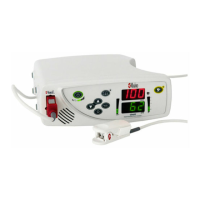1-4 Rad-8 Signal Extraction Pulse Oximeter Operator’s Manual
1
overview
1
Pulse Oximetry
SpO
2
GENERAL DESCRIPTION
Pulse Oximetry is a continuous and noninvasive method of measuring the level of
arterial oxygen saturation in blood. The measurement is taken by placing a sensor on a
patient, usually on the fi ngertip for adults and the hand or foot for neonates. The sensor
is connected to the Pulse Oximetry instrument with a patient cable. The sensor collects
signal data from the patient and sends it to the instrument. The following fi gure shows
the general monitoring setup.
3
1
2
®
1. Instrument
2 Patient Cable
3. Sensor
PRINCIPLE OF OPERATION
Pulse Oximetry is governed by the following principles:
1. Oxyhemoglobin (oxygenated blood) and deoxyhemoglobin (non-oxygenated
blood) constituents differ in their absorption of visible and infrared light (using
spectrophotometry, see fi gure below).
Absorption Spectra
Oxyhemoglobin
Deoxyhemoglobin
2. The amount of arterial blood in tissue changes with your pulse (photoplethysmography).
Therefore, the amount of light absorbed by the varying quantities of arterial blood
changes as well.

